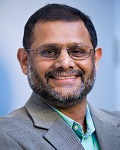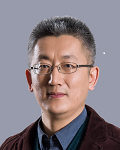Keynote Speakers

Prof. Keshab K. Parhi, IEEE Fellow,
AAAS Fellow
University of Minnesota, USA
Speech Title: Machine Learning and
Deep Learning Systems: Low-Energy VLSI
Architectures and Applications
Abstract: Machine learning and
data analytics continue to expand the fourth
industrial revolution and affect many
aspects of our lives. This talk will explore
machine learning applications in data-driven
neuroscience, and low-energy implementations
of machine learning and deep learning
systems. Data-driven neuroscience can
exploit machine learning approaches
including deep learning to generate
hypotheses associated with biomarkers for
specific neuro-psychiatric disorders. In the
first part, I will talk about use of machine
learning to find biomarkers for epilepsy. In
the second part of the talk, I will talk
about approaches for energy-efficient
implementations for both traditional machine
learning and deep learning systems. I will
talk about the roles of feature ranking and
incremental-precision approaches in reducing
energy consumption of traditional machine
learning systems. I will then talk about
reducing energy consumption in deep learning
systems. I will describe our recent work on
Perm-DNN based on permuted-diagonal
interconnections in deep convolutional
neural networks and how structured sparsity
can reduce energy consumption associated
with memory access in these systems.
Bio: Keshab K. Parhi received the B.Tech. degree from the Indian Institute of Technology (IIT), Kharagpur, in 1982, the M.S.E.E. degree from the University of Pennsylvania, Philadelphia, in 1984, and the Ph.D. degree from the University of California, Berkeley, in 1988. He has been with the University of Minnesota, Minneapolis, since 1988, where he is currently Distinguished McKnight University Professor and Edgar F. Johnson Professor of Electronic Communication in the Department of Electrical and Computer Engineering. He has published 650 papers, is the inventor of 30 patents, and has authored the textbook VLSI Digital Signal Processing Systems (Wiley, 1999) and coedited the reference book Digital Signal Processing for Multimedia Systems (Marcel Dekker, 1999). His current research addresses VLSI architecture design of machine learning systems, hardware security, data-driven neuroscience and molecular/DNA computing. Dr. Parhi is the recipient of numerous awards including the 2017 Mac Van Valkenburg award and the 2012 Charles A. Desoer Technical Achievement award from the IEEE Circuits and Systems Society, the 2004 F. E. Terman award from the American Society of Engineering Education, the 2003 IEEE Kiyo Tomiyasu Technical Field Award, the 2001 IEEE W. R. G. Baker prize paper award, and a Golden Jubilee medal from the IEEE Circuits and Systems Society in 1999. He served as the Editor-in-Chief of the IEEE Trans. Circuits and Systems, Part-I during 2004 and 2005. He was elected a Fellow of IEEE in 1996 and a Fellow of the American Association for Advancement of Science (AAAS) in 2017.

Prof. Deming Chen, IEEE Fellow
University of Illinois at Urbana-Champaign, USA
Speech Title: Cognitive Computing
on Heterogeneous Hardware Systems for the AI
Revolution
Abstract: Many envision that AI
(artificial intelligence) will usher in the
next iteration of technology revolution,
where humans and machines will work
side-by-side to augment, enhance, or
accelerate our ability to analyze, learn,
create, and think. There are successful
stories emerging fast already, such as IBM
Watson, Microsoft HoloLens, and Google
AlphaGo. One essential component to enable
the new AI revolution is IoT (Internet of
Things). Cognitive computing can learn from
the rich IoT data, reason from models, and
most importantly interact with us to perform
complex tasks (ranging from healthcare to
education to financial services) better than
either humans or machines can do by
themselves. Meanwhile, high-performance
computing would be of paramount importance
to help achieve the grand vision of
cognitive computing. In this talk, Prof.
Chen will share his recent research results
on machine learning, reconfigurable
computing, GPU computing, and cognitive
application benchmarking. He will also
present his recent work on extremely fast
software and hardware modeling and the
automated software/hardware co-design for
accelerating cognitive computing workloads.
Compelling AI applications will be
introduced as well, such as autonomous
driving and facial recognition.
Bio: Dr. Deming Chen obtained his BS in computer science from University of Pittsburgh, Pennsylvania in 1995, and his MS and PhD in computer science from University of California at Los Angeles in 2001 and 2005 respectively. He joined the ECE department of University of Illinois at Urbana-Champaign in 2005 and has been a full professor in the same department since 2015. His current research interests include system-level and high-level synthesis, machine learning, GPU and reconfigurable computing, and hardware security. He has given more than 110 invited talks sharing these research results worldwide. He obtained the Arnold O. Beckman Research Award from UIUC in 2007, the NSF CAREER Award in 2008, and eight Best Paper Awards. He also received the ACM SIGDA Outstanding New Faculty Award in 2010, and IBM Faculty Award in 2014 and 2015. In 2017 and 2019 respectively, he led a team to win the first place of DAC International System Design Contest in the IoT domain. He is included in the List of Teachers Ranked as Excellent in 2008 and 2017. He is the Donald Biggar Willett Faculty Scholar of College of Engineering, an IEEE Fellow, an ACM Distinguished Speaker, and the Editor-in-Chief of ACM Transactions on Reconfigurable Technology and Systems (TRETS). He is also involved with several startup companies, including co-founding Inspirit IoT, Inc. in 2016.

Sunny Zhang, Principle Engineer
Director of Communication Infrastructure Research, Intel Labs China
Speech Title: Wireless signal processing at AI era
Abstract: About 8 years ago, there
were one paper asked the question and talked
about "is PHY research dead?", of course,
you can imagine that the conclusion from a
wireless researcher definitely will be not,
the paper also proposed quite a few
innovation directions, such as short code,
impairments of mmWave which are actually the
key features of 5G now, which also talked
about "wireless research is not as vibrate
as before", "implementation" should be taken
more attentions. 8 year later, if we revisit
this question, we see the trend that
wireless system become extremely complex on
the standard and also implementation,
industry wants to re-shape the wireless
eco-system with open architecture and
interface, power efficiency and higher
frequency became the focal point of wireless
implement, for signal processing side, AI
technology is emerging which become another
toolbox for wireless research but the
directions are not clear on what can be done
and what should done. In this talk, will
talk about the problem in wireless system,
where AI techniques can be applied such as
on channel estimation, on MAC scheduler, on
massive MIMO beamforming, the possibility
and challenge to bring that into reality, as
well as from design perspective, how could
we apply wireless signal processing + AI
processing together to solve practical
problem on radar sensing, how can we combine
wireless processing and AI processing
together on same processor.
Bio: As principle engineer and
director of communication infrastructure
research in Intel labs China, Sunny is 15
years veteran on wireless communication
system and wireless signal processing
design. Sunny initialized and led Intel
multi-radio coexistence, digital enhanced
radio and Cloud Radio Access Network
research effort, developed the first highly
optimized LTE stacks on general purpose
architecture, the first scalable and high
performance Cloud RAN BBU pool reference
design, which became Intel FlexRAN 4G and 5G
product, widely used by cellular industry.
Sunny leads Intel Lab China’s 5G research on
Radio Access Network architecture, proposed
5G low layer split massive MIMO solutions,
widely adopted by industry. Sunny also leads
Intel lab China team designing high
performance programmable wireless processor
to achieve efficiency and programmability at
the same time. Sunny and his team received 1
Intel lab Gordy Award, and Intel Achievement
Award in Intel, which are the highest award
in Intel lab and Intel.
Prior joined Intel, Sunny was as the
physical layer architect, designed the first
passive optical network in 2001. From 2002
to 2004, he was at startup companies in
Silicon Valley, and responsible for optical
devices and RFID devices design.
Sunny got bachelor and master degree in
Tsinghua University and Beijing University
of post and telecom communication
respectively. Published 10+ papers and filed
10+ patents.
